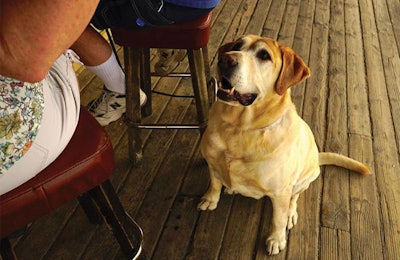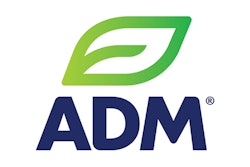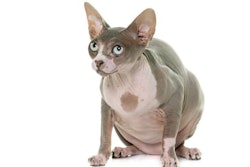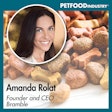
The pet food industry is among the first lines of defense in the fight against pet obesity. As the most obvious go-to for overweight pet lifestyle changes, pet food has long since expanded to include a wide variety of formulations purporting weight control or weight loss, in both specialized veterinary and retail store options. But in spite of the plethora of choices out there for consumers, pet obesity numbers continue to rise. According to the Association for Pet Obesity Prevention (APOP), which conducts an annual survey focusing on pet obesity, nearly 59 percent of cats and 54 percent of dogs in the US are overweight or obese.
But that’s not all. The 2016 survey asked questions about consumers’ and veterinarians’ perceptions of various aspects of pet food diets — and the disparity was stark. According to the survey, just 6 percent of pet owners believe that corn is healthy for dogs, compared to 48 percent of veterinarians. Sixty-one percent of pet owners think that low- or no-grain diets are healthier for dogs (compared to 25 percent of veterinarians), and 35 percent of pet owners believe that raw diets are healthier for dogs and cats (compared to just 15 percent of veterinarians).
With such an obvious disconnect even between veterinarians and the pet owners they see regularly, it’s no wonder that consumer education has become an increasing focus among pet industry professionals who want to ensure that both pets and the people who love them remain healthy.

According to APOP's annual survey, nearly 59 percent of cats and 54 percent of dogs in the US are overweight or obese. | PetObesityPrevention.org
Pet owners and the “fat pet gap”
“There exists a stigma around pet food weight control formulations,” said Dr. Ernie Ward, founder of APOP and Petplan Veterinary Advisory Board member. “We’ve progressed to a time where we have a pretty good understanding of what works in weight loss for pets and people. We understand the role of carbohydrates, proteins and fat, what combinations that seem to work best, ingredient profiles that might promote lean muscle, preservation as well as losing excess fat tissue. So, the science we’ve got. But then what happens is, you put a label on that, and you call it a weight-loss or reduction or low-fat diet, and I think there’s a stigma associated with that."
“And this is where that whole fat pet gap becomes important and apparent,” he said. “Because we still have this gap with the average pet owner recognizing excess weight in their pet. And so when we slap these great formulations together, and these new labels to try to identify and help pet owners, they’re still saying, ‘but it’s not me.’”
Getting the pet owner on board is the number one step in helping to control a pet’s weight. “Honestly, the formulas that we have work well if they’re fed properly,” said Gary Davenport, companion animal technical manager for ADM Animal Nutrition. “You’ve got to overcome the owner, so that’s going to be your first line of defense for an effective weight management program.” But it’s not easy. “I would first ask the questions, how well are we doing that for humans, in terms of controlling obesity?” said Davenport. “We’re not, because those rates continue to increase, as well. No matter what we can put out there, either product-wise or education-wise, it’s an uphill battle. You still try to put the right products in the bowl for the pet, but then there has to be the discipline that comes with owning and feeding that pet from the owner.”
It's not easy, but it is necessary, and the industry can play a significant role. "The industry can work on informing pet owners on the seriousness of [pet obesity] and highlight the health risks and issues associated with overweight pets," said Trevor Faber, PhD, nutritionist for the companion animal division of Trouw Nutrition. "Many of the same health issues can occur in pets as with humans (joint issues, diabetes, etc.). Pet owners are in control of the pet’s food consumption, so the owner dictates how much food is offered. When treats are offered, consumers need to be educated on how those calories offset the food offered at the next meal."
But it’s more than just pet owners who need educating. “When we talk about educating the consumer, I think that’s our first goal,” said Kelly Ison, founder and CEO of Einstein Pets. “But the underlying problem we also have to educate is the retail space. If we’re not educating them about why they should point consumers in a certain direction, it doesn’t do any good. You can educate the consumer all you want, but if they’re going to walk into a retail store and buy something, and the retailer directs them to another line, and they don’t know what the owner is already feeding their pets, it just goes right out the window.”
Weight-control pet food popularity and the need for consumer education
For all that there’s a clear communication gap between the pet food industry and other relevant parties when it comes to pet obesity, there’s also a significant call for weight-control formulas. “Weight-control pet foods are very popular,” said Shiguang Yu, PhD, MBA, global technical manager – pet nutrition at DSM Nutritional Products. “There are two major categories: therapeutic diets and grocery pet foods. Therapeutic diets are sold through veterinary clinics and are typically used to induce body weight loss. Grocery pet foods for weight control are sold in pet specialty stores, supermarkets and local grocery stores. Most major pet food companies have weight-control products in their product portfolios.”
The need for education once again comes in as pet food manufacturers balance the nutritional needs of pets with what consumers think is best for their pets. “We have over 500 veterinarians, scientists and nutritionists on staff at Purina who are continually striving to provide the highest quality and 100 percent complete and balanced nutrition for pets at every stage of life,” said Paul Cooke, vice president of industry relations for Nestlé Purina Pet Care. “Our nutritional philosophy has always been to look at the nutrients a dog or cat needs first, versus focusing on the ingredients a pet parent wants (or doesn’t want) to see.”
And those nutritional needs are particularly important when weight-loss formulation is involved. "For weight management diets that are built on the premise of providing less volume of food per day, one needs to remember to increase the concentration of numerous nutrients, particularly vitamins and minerals, in order to meet the daily requirement," said Faber. "If an animal is consuming less food, it may not be meeting the nutrient requirements with such little food. Therefore, more nutrient per bite is needed."
In the end, it comes down to cooperation among all parties to ensure pets remain healthy and happy. “We all know that a complete and balanced diet provides total nutrition,” said Cathy Enright, CEO and president of the Pet Food Institute. “Those nutrients can be provided by a variety of ingredients. But I wonder how many people know how many calories their particular cat or dog should consume? I think that’s a question that pet owners should ask vets, vets should know to ask and pet food manufacturers should work with vets as well as consumers to make sure that folks ask that question or, alternatively, get the answer to that question.
“Our companies have a role, our vets have a role and consumers have a role,” she said. “We’re all responsible. It’s multiple steps. I don’t think we could reach every family that shares its home with a companion animal with one approach. What’s key is multiple approaches.”
Expert opinion: Bridging the communication gap between pet food consumers and industry
“Pet obesity isn’t a problem until it’s a catastrophe,” says Dr. Ernie Ward, founder of the APOP and Petplan Veterinary Advisory Board member. “The root cause is that people aren’t aware, and I don’t know how to overcome that. I do know that we have to continue to do our best to educate the public, because that’s the only thing we can do. I do know it’s very frustrating, and I think that’s what comes back to the industry and the veterinary profession. The solution is going to be to develop clever ways to get the message out there, so pet owners can quickly identify that obesity is a problem and the pet food industry has a solution for it.”
Ward says he’s a big proponent of increasing transparency on pet foods’ caloric content in order to help consumers make sense of how they should feed their pets. “It’s not an easy solution,” he says. “That’s why we’re still struggling with it. When it comes to weight loss, it’s not as simple as just feeding pets less, because that inherently is really difficult. How do you know how much to feed to begin with?”
Some of the education may need to be blunt. “The other thing the industry can really do is to continue to emphasize in their messaging that a healthy weight equals a better quality of life,” he says. “We tend to make it about other things, but ultimately what impacts pet owners more than anything else is suffering.”
And no matter what, it’s likely going to take cooperation from everyone involved in the pet industry. “We all have to work in concert,” says Ward. “The internet runs on hate; as an industry, we have to start working together and realize that our ultimate goal is provide the best care, the best nutrition, for as many pets as possible. We’ve got to do a better job of coming together. The veterinary world and the pet food industry have the same goals: to enhance the quality of life and well-being of pets. Obesity is that natural intersection point, because it’s not only a medical condition, it’s a ‘food bowl disease’. The pet food industry can help me with better products, more information, more transparency, increasing the reach of the message that, hey, the decision you make about what to feed your pet is the most important decision you’ll make for them every day. Let us help you with that.”


















